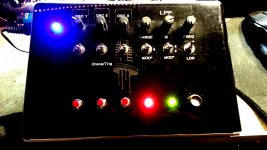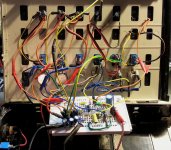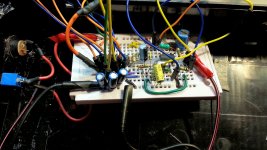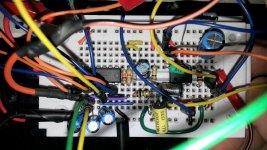So I built this thing over the weekend. Didn't take long but I did spend hours swaping out components for different sounds. This is just the start, I can see a monstrocity in the future! Heh.
Let me know what you guys think!
Cheers
DIY 3 oscillator synthesizer drone machine with resonant LPF - YouTube

Let me know what you guys think!
Cheers
DIY 3 oscillator synthesizer drone machine with resonant LPF - YouTube

Well, what fun!! I like it.
It blows my old project away. When i was learning, and this was back in the 1950s, so 50+ years ago, I discovered relaxation oscillators. Very simple. You start with a high voltage supply. I think mine was 300v, I used that for everything. But 90 would have been enough I bet. I had a zillion 1 meg resistors so I used them. You put a resistor and cap in series across the B+, and a neon lamp parallels the cap. The cap will charge up at the rate the resistor makes with the cap value, until it gets to the firing voltage of the neon bulb. The bulb flashes, discharging the cap and the cycle repeats. Bigger cap, slower cycle.
Started with a simple one with a largish cap so it just flashed. I then found that I could cascade one of these cells with others. And one would modulate the other. And then I discovered I could sample the signal with a cap into a small amp and listen. A sort of siren effect was one possibility.
But that was only a distant ancestor to your thing.
It blows my old project away. When i was learning, and this was back in the 1950s, so 50+ years ago, I discovered relaxation oscillators. Very simple. You start with a high voltage supply. I think mine was 300v, I used that for everything. But 90 would have been enough I bet. I had a zillion 1 meg resistors so I used them. You put a resistor and cap in series across the B+, and a neon lamp parallels the cap. The cap will charge up at the rate the resistor makes with the cap value, until it gets to the firing voltage of the neon bulb. The bulb flashes, discharging the cap and the cycle repeats. Bigger cap, slower cycle.
Started with a simple one with a largish cap so it just flashed. I then found that I could cascade one of these cells with others. And one would modulate the other. And then I discovered I could sample the signal with a cap into a small amp and listen. A sort of siren effect was one possibility.
But that was only a distant ancestor to your thing.
This type of oscillator produces sawtooth waves. These have long been the favoured base signal for synthesizers. Nowadays it is much easier to use small thyristors (thyristor = SCR) or an "emulated thyristor" using two complementary small signal transistors than neon lamps. If you use a current-source instead of a resistor for the time-constant, the sawtooth would look closer to perfection. If you use a voltage controlled current source you can make it a VCO.
Regards
Charles
Regards
Charles
I wish they were sawtooth waves. These are square waves. I can change them to saw waves with an integrator.
This type of oscillator produces sawtooth waves. These have long been the favoured base signal for synthesizers. Nowadays it is much easier to use small thyristors (thyristor = SCR) or an "emulated thyristor" using two complementary small signal transistors than neon lamps. If you use a current-source instead of a resistor for the time-constant, the sawtooth would look closer to perfection. If you use a voltage controlled current source you can make it a VCO.
Regards
Charles
I wish they were sawtooth waves. These are square waves. I can change them to saw waves with an integrator.
IIRC you mentioned somewhere that you use a diode in the feedback of the oscillators. In this case you'll just have a look at the voltage over the capacitor at the input of the Schmit-triggers. There you should actually have a waveform close to a sawtooth.
Regards
Charles
Careful now!
Those things are addictive and can lead to having this in your home:
http://drupal.soundonsound.com/site...public/imagelibrary/A/AS_03.jpg?itok=eOQii4B0
Those things are addictive and can lead to having this in your home:
http://drupal.soundonsound.com/site...public/imagelibrary/A/AS_03.jpg?itok=eOQii4B0
Ah. Yes, when 2 OSC are running with the diode/LED mod it produces a pretty complex waveform. I do wish this chip gave me the option of Saw, Tri and Sine as well off the bat.
IIRC you mentioned somewhere that you use a diode in the feedback of the oscillators. In this case you'll just have a look at the voltage over the capacitor at the input of the Schmit-triggers. There you should actually have a waveform close to a sawtooth.
Regards
Charles
This one, yes. I have made many others from schematics in the past. This is my first on my own. Once you make square waves from Schmidt triggers, it's easy to duplicate without referencing. As far as the filter goes, I've built a few stompboxes, one being an inductor-less wah, that was the inspiration for the filter.
Yeah pass it on! I can draw up a schematic for this if you'd like.
Yeah pass it on! I can draw up a schematic for this if you'd like.
Don't tell us that you did this without schematics? Since it is not circuit bending but obviously clever prototyping. I would like to show this to my students for inspiration.
Last edited:
Tell me about it 


Careful now!
Those things are addictive and can lead to having this in your home:
http://drupal.soundonsound.com/site...public/imagelibrary/A/AS_03.jpg?itok=eOQii4B0
not just '50s sounds like ya could hav done all the audio effects for the new (well couple a years old now) tron 2Cool! Very 1950's Sci-Fi.
An old principle just popped up in my mind. I have an old paperback somewhere about synthesizers and electric pianos. There they made sawtooth waves by using frequency dividers and wighted summing of their outputs. They used discrete circuitry back then but nowadays I would build something like that with a CD4046 whose VCA is misused as the clock and a CD4040 binary counter as frequency divider. The CD4046 has an inhibit input for the VCO which could be used to mudulate on and off. And FM modulation would of course also be possible with this VCO.
This topology would of course loose the simplicity appeal of the circuits using Schmitt-triggers.
Regards
Charles
This topology would of course loose the simplicity appeal of the circuits using Schmitt-triggers.
Regards
Charles
- Status
- This old topic is closed. If you want to reopen this topic, contact a moderator using the "Report Post" button.
- Home
- Live Sound
- Instruments and Amps
- 3 oscillator drone machine noise maker


